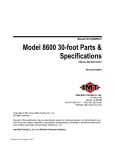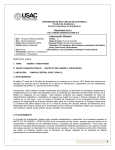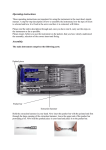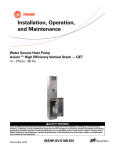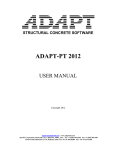Download d-CABLE - Yieldpoint
Transcript
d-CABLE – User Manual YieldPoint Inc. Jan 2011 Copyright © 2011 by YieldPoint Inc. The Information contained herein is the exclusive property of YieldPoint Inc., except as otherwise indicated and shall not be reproduced, transmitted, transcribed, stored in a retrieval system, or translated into any human or computer language, in any form or by any means, electronic, mechanical, magnetic, optical, chemical, manual, or otherwise without expressed written authorization from the company. The distribution of this material outside the company may occur only as authorized by the company in writing. YieldPoint hardware and software products are not designed to be used in the diagnosis and treatment of humans. Windows TM is a registered trademarks of Microsoft Corporation. Warranty and Service Policy Product Warranty YieldPoint Inc warrants the instruments described in this manual to be free from defects in materials and factory workmanship to the original buyer. This warranty is contingent upon proper use of the equipment, and does not cover equipment that has been modified or has been subjected to abusive physical or electrical stresses. YieldPoint Inc., agrees to repair or replace, at its sole discretion, any instrument that fails to perform as specified within 6 months after date of the original shipment from the factory, or 3 months after the date of installation, whichever date comes first. Yieldpoint Inc., reserves the right to make substitutions and modifications in the specifications of equipment that do not materially or adversely affect the performance of the equipment. New equipment may be returned within 30 days of shipment with prior approval. New items which are less than thirty days old after shipment may be returned for credit, less a minimum restocking and testing charge of twenty percent of the list price upon factory approval only, provided the customer pays all shipping and handling charges. Specially ordered, or modified goods, or goods which have been used or have been unpacked, or goods which have been shipped more than thirty days prior are not returnable. The information contained in this manual is subject to change without notice. YieldPoint Inc. makes no warranty of any kind with regard to this material, including, but not limited to, the implied warranties of merchantability and fitness for a particular purpose. Further, YieldPoint Inc., assumes no responsibility for any errors that may appear in this manual and makes no commitment to update, or keep current, the information contained in this manual. Service Policy Units within the warranty period returned for repair, test, and recalibration are serviced at no charge in accordance with the terms of the warranty policy. The Customer pays all transportation and other charges to the factory. Units out of warranty returned for repair, test, and/or recalibration are handled on a time and material basis. If requested, or if costs exceed 50% of current list price, YieldPoint Inc., advises the customer prior to making the repairs. Such repairs are performed at the customer’s expense. Typical test, recalibration, and repairs are 25% of the instrument’s current list price. Transportation charges both ways are at the customer’s expense. Please be sure all returns are shipped with the following information included: 1.Your company Name with Billing and Shipping Addresses. 2.A complete description of your problem, or re-calibration data. 3.The contact person at your company, with their telephone and facsimile numbers. 4.Non-Warranty returns additionally need your Purchase Order Number. Please pack your returned instruments in their original shipping cartons, or in equivalent strong protective shipping cartons. d-CABLE User Manual Jan 2011 2 The d-CABLE The d-CABLE is based on the a miniature inductive strain gauge (Figs 1 and 2) small enough to be recessed into a surrogate tubular king-wire. When the ends of the strain gauge are secured at specified locations within the king-wire it will measure how a certain length of the cable bolt is stretching in response to loading(Figure 2). Either a single gauge (for end anchored cables spun in resin) or an array of such strain gauges may be specified. They may be concentrated at locations where it is predicted that the cable may intersect a known geological structure. The base-length (BL in Figure 1) between the ends of the strain gauge is specified by the customer. During manufacturing the entire strain gauge array is independently manufactured and calibrated and then recessed into the king-wire and swaged in place. Since the strain gauges are recessed along the cable rather than being housed in an instrumentation head, the “signal processing head” of the d-CABLE is reduced to a diameter almost equal to the diameter of the cable. Consequently the cable can de more easily used in situations that require plating or pre-tensioning. The output signal from the d-CABLE is a digital signal RS485 serial (9600,8,N,1) signal with the serial number, Sensor_Type and data multiplexed on a single twisted pair. The reading comprises multiple values (one for each strain gauge) directly in tons so that the user has a direct and immediate indication of cable load without having to enter the data in a spreadsheet. SWAGE BL SWAGE Figure 1. The ends of the strain gauge are swaged to the tubular kingwire. BL is the baselength of the inductive strain gauge (between 200 and 2500mm) which can be specified by the customer. The strain(e) in the cable is calculated from the change in strain gauge output/(BL -the baselength of the strain gauge). The strain multiplied by the stiffness factor of the cable provides a result directly in tons. d-CABLE User Manual Jan 2011 3 DISPLACEMENT SENSOR DETAIL 5 3 1 5 2 7 8 6 4 3 1 1.Carbon Fiber rod 2.Ferrite 3. Thin Wall PolyImide Tube 4. Coil wound on polyimide tube 5. SS tempered tube 6.Peripheral wires of cable 7.Rock 8.Cement Borehole Leadwire Signal processing and telemetry assesmbly. 300mm Figure 2: Detail of the miniature inductive strain gauge that can be recessed into the tubular king-wire such that the strain can be determined accurately at location rather than translated to an instrumentation head at the end of the cable. NOTE: The YieldPoint manual readout unit (d-READER ) outputs load directly in tons(resolution 0.01tons). d-CABLE User Manual Jan 2011 4 How is the DETECT Cable different (compare with US patent # 5,929,341)? The instrumented cable bolt outlined by Bawden and Hyett (US patent 5,929,341) describes a load measuring device which comprises rock support means having an internal longitudinal cavity extending through it such as to accommodate a plurality of rigid wires each of which is anchored at a predetermined anchor point within said cavity and at its other end is connected to a longitudinally moveable spring loaded actuator provided with an electrical contact to a linear displacement sensing means. To all intents and purposes the design is a miniature multi-rod borehole extensometer built into the king-wire of the cable. In US patent 5,929,341 the instrument output signal is a series of voltages (directly proportional to mm of movement) that are transmitted on different conductors, and the load can be determined from the strain (difference in voltage between adjacent nodal points) multiplied by a stiffness factor. Therefore each strain (i.e. load) determination depends on two adjacent displacement measurements so that an error in one will result in a spurious interpretation of load - usually one load point will be too low and the adjacent load point will be too high or vice-versa). To further complicate matters for the design in US patent 5,929,341 the displacements are measured relative to the instrumentation head at the end of the cable, and which may move independently of the cable. In contrast, the d-CABLE comprises an array of independent miniature strain gauges (described above) within the cable by securing both ends of a miniature strain gauge to the tubular king-wire. Each strain gauge provides a definitive measurement of strain from which the Load(in tons) can be computed directly. The SMART cable design in US patent 5,929,341 has a number of additional disadvantages: (i)The displacement must be translated from a predetermined point within the cable to the instrumentation head by the spring loaded wire, and is susceptible to thermal variations and cable flexure. For example the reading will vary as the cable is coiled for transportation and on uncoiling hysteresis (i.e. non-recovery of this effect due to friction in the system) will cause initial readings at low loads to be unpredictable. (ii) The voltage readings need to be processed in a spreadsheet prior to interpretation. This prevents instantaneous manual interpretation of load (i.e. Factor of Safety) and the use of local alarm systems. (iii) The strain at critical points in the cable bolt may be underestimated because of the long strain base-length (typically >1m). This is a potentially important problem in massive blocky ground where deformations may be concentrated at a single discontinuity or crack. The resolution of the potentiometers and other associated inaccuracies prevent better resolution. d-CABLE User Manual Jan 2011 5 (iv) The potentiometer displacement transducers are inaccurate (linearity 5%FS) and are susceptible to water and blast damage. (v) The analog voltage signal transmitted is not suitable for the harsh mining environment. SPECIFYING Nodal Locations for The d-CABLE. The d-CABLE can be applied to any cable bolt configuration: Plain Strand, Garford Bulb or de-bonded cable. It is also applicable to cables that will be spun in resin. For the d4CABLE the user has 4 load measurements, but has considerable flexibility with respect to how these are configured. For each strain gauge the user needs to specify the centre-point and base-length (CP/BL in mm or m). For example consider the cable bolt in Figure 3, which is a 18” spacing bulge (garford bulb) cable with a 2m de-bonded length. The user may specify the strain gauges as shown. The load between the first two (left most) bulges will reflect the plating posttensioning process and may vary quite significantly between the de-bonded section and the plate, and therefore a 500mm baselength is specified. If the user wanted to see more resolution in this zone, perhaps to investigate the effectiveness of the faceplate, then they could specify two strain gauges of 250mm along the same section centered at 790mm and 1040mm.The 1m baselength within the debonded section will provide an accurate measurement of load at that point, since the load will be constant along the whole 2m length. The final two gauge towards the toe of the hole will indicate how and whether the load decays towards the end of the cable. 2m 0.0m 7.0m debond 410/800 1710/1800 3510/1800 5660/2500 CP/BL Figure 3. The strain gauge layout for a DETECT 4EX. The CP/BL specifications are in mm. NOTE: The maximum strain gauge baselength is 1000mm and the minimum 200mm. d-CABLE User Manual Jan 2011 6 INSTALLATION OF THE d-CABLE Option 3 Option 2 Continuous Stainless Steel Tube Option 1 Leadwire Leadwire Signal processing and telemery head Figure 4: Installation options for the d-CABLE If there is no need to install the d-CABLE then it can be installed just as regular cable-bolt (Option 1). The d-CABLE can be installed with a faceplate, but it important to inform YieldPoint Inc. at the time the instrument is ordered. The most effective strategy for installing a faceplate is to recess the instrumentation head to the toe of the borehole and retrieve the leadwires through a continuous steel conduit. The Head of the d-CABLE and the steel conduit are united at a friction coupling consisting a capped length of cream coloured CPVC tube. The steel conduit is attached to the cable with the BLACK cable ties which should not be removed during installation Unwrapping the cable. 1. Plug the cable into the d-READER and take a reading with the instrument coiled.The instrument should scroll through its anchors. 2. Cut the smaller white cable ties to release the regular leadwire from the cable. 3. Holding the head of the cable carefully cut the large white cable ties beginning at the toe of the cable. This is most easily accomplished with the cable in an upright orientation. Remember: considerable energy is stored in a coiled cable so care must be taken. d-CABLE User Manual Jan 2011 7 4. Lay the cable straight and if necessary straighten the steel conduit. Do not cut the black cable ties. IMPORTANT: The Yellow tape indicates the end-point of the instrumentation array. Install the cable in the borehole: 5. Blow all down-holes and in general make sure the holes are as clean as possible. 6. In poor ground insert a regular (non-instrumented) cable and grout hose to make sure the borehole is viable. 7. Cut a length of grout hole to the appropriate length for the d4CABLE . Remember to cut the end of the grout hose at a 60degree angle to make insertion easier. 8. Securely attach the grout hose to the instrumented end of d4CABLE with electrical tape (toe to collar grouting assumed). The angled end of the grout hose should be within 150mm of the capped CPVC tube at the instrument head. 9. Insert into the borehole carefully by pushing on the grout hose. Tape the grout hose to the d4CABLE at regular intervals during insertion. IMPORTANT – ZERO The d-CABLE LOAD Following shipping, installation and grouting, the load values may be offset compared to their initial factory readings. It is recommended that the instrument be “zero-ed”.This should be done after the instrument has been installed and the cement grout has completed its early exothermic cure ( e.g. 2 days after installation). To zer the d-CABLE plug the instrument into the d-READER for aprox 1 min ( at least 8 reading samples). IMPORTANT: This operation is necessary even if the d-CABLE is reading zero values after installation. DATA REDUCTION FOT THE DETECT CABLE The d-CABLE can be applied to any cable bolt configuration: Plain Strand, Garford Bulb or de-bonded cable. It is also applicable to cables that will be spun in resin. For the d4CABLE cable the user has 4 load measurements which are arranged end-to-end ( recommended configuration). Obviously the 4 strain gauges are measuring the stretch along the entire length of the cable. d-CABLE User Manual Jan 2011 8 Leadwire 3.5m 0m SG #1 7.0m 10.5m SG #2 SG #3 14.0m SG #4 Meas.Load 1.90tons 1.20tons 7.80tons 13.20tons Gauge Disp (mm) 2.22mm 1.40mm 9.10mm 11.2mm Disp fromHead (mm) 2.22mm 3.62mm 12.72mm 23.92mm Figure 5: Configuration, Load measurement and corresponding displacements along a d-CABLE. Assume a 14.5m long cable (nominal 15m) with the anchors evenly spaced at 3.5m. The measured load values (using d-READER) are shown in the top line of the table in Fig. 5. These are the values directly measured from the instruments and represent 4 completely independent load measurements along the cable. These values are based an average strain along each strain gauge and therefore when plotted on a graph should be plotted at the midpoint of each gauge. Calculation of Corresponding Displacement Profile along the Cable Bolt. The corresponding gauge displacement (i.e. the stretch that each independent gauge has experienced for a given load) can be calculated from: dSG = (LoadSG x lSG )/kcab Eqn 1 where LoadSG is the value output from the instrument, kcab is the stiffness of the cable ( 3tons/mm/m) and lSG (in m) is the length of the gauge. kcab, the cable stiffness, is the load required to stretch a 1m length of cable by 1mm. The second row of Fig. 5 is the displacement for each strain gauge in mm. calculated from Equation 1. e.g. the instrumented cable has stretched 9.1mm between the nodes at 7.0m and 10.5m (along SG #3). The third row of Figure 3 represents the cumulative displacement along the instrumented cable, which can be calculated because the strain gauges are d-CABLE User Manual Jan 2011 9 arranged end-to-end. The values are determined by adding the individual gauge displacement together: Cum Disp node N = dSG1 + dSG2 + … dSG node N So for node 1 the value is simply: Cum Disp node 1 = dSG1 And for node 2: Cum Disp node 2 = dSG1+dSG2 And so on…. When plotted (Figure 6) these displacement values should be placed at the nodal points rather than in the middle of the strain gauge. Load (Tons) Blue Cum. Disp. (mm) Red 25 20 15 10 5 0 0 5 10 15 Distance along the cable (m) Figure 6. Load and the corresponding Cumulative Displacement along a DETECT cable bolt. In this manner both the load and displacement along the d-CABLE can be accurately determined. d-CABLE User Manual Jan 2011 10 Reference Point. When calculating the displacement profile it is necessary to assign a reference point for which the displacement is zero. In the example the reference was the head of the cable ( 0.0m) but it many case it will be at the toe of the cable (i.e. deepest point in the rock). A spreadsheet is provided that provides the user with a template example: Link: d-CABLE User Manual Jan 2011 11 APPLICATIONS d-CABLE have been widely used for many application in both civil and mining projects including: Slope monitoring. Monitoring cable reinforcement in tunnels and drifts Monitoring cable reinforcement in stopes and other large openings Monitoring cables in fill mats Monitoring ground anchors Monitoring strand reinforced concrete Monitoring tie-backs In all cases monitoring with d-LOGGERs and DESTINY add significant value to the project. 2 Load tonnes ) 1.5 Anchor4 Anchor 3 Anchor 2 1 Anchor 1 Temp Change(C) 0.5 0 Temp(C) -0.5 -1 -1.5 -2 200 220 240 260 280 300 320 340 360 380 Time (hours) Figure 5: d4CABLE data collected using a d1LOGGER. d-CABLE User Manual Jan 2011 12














